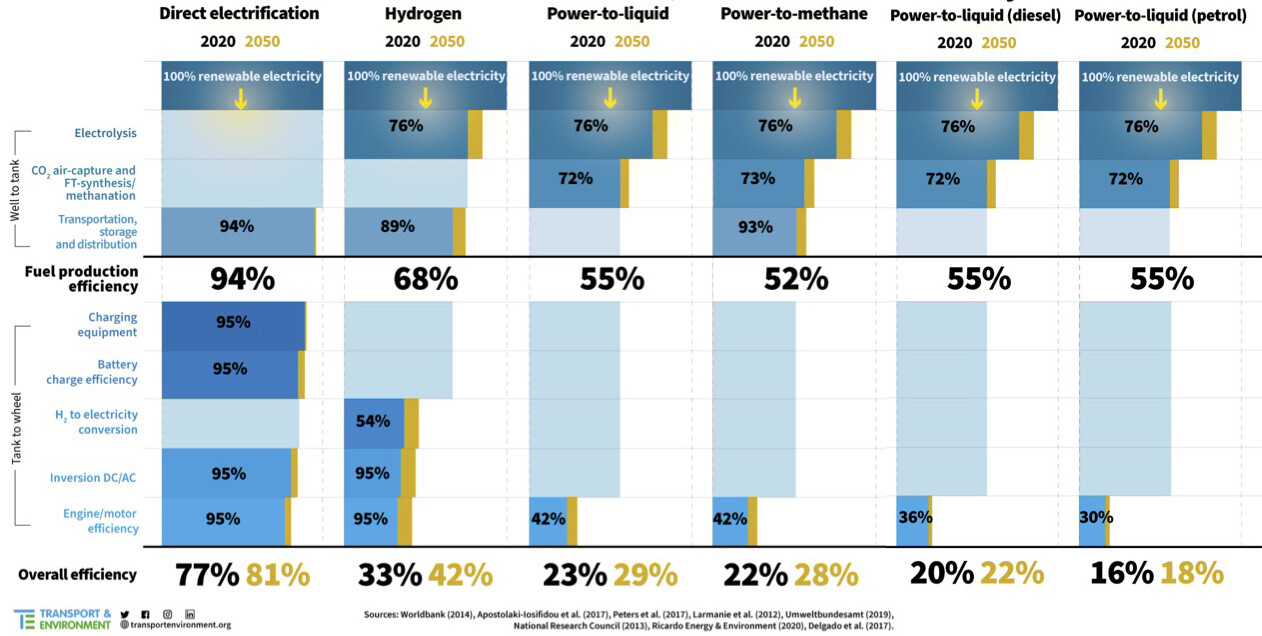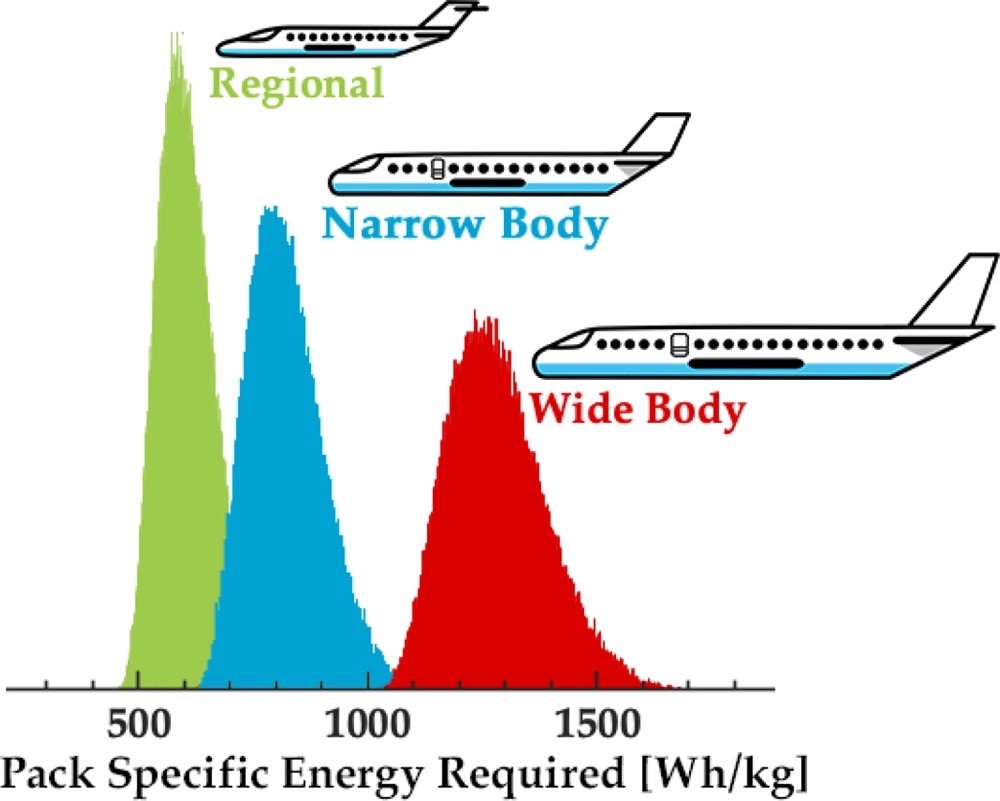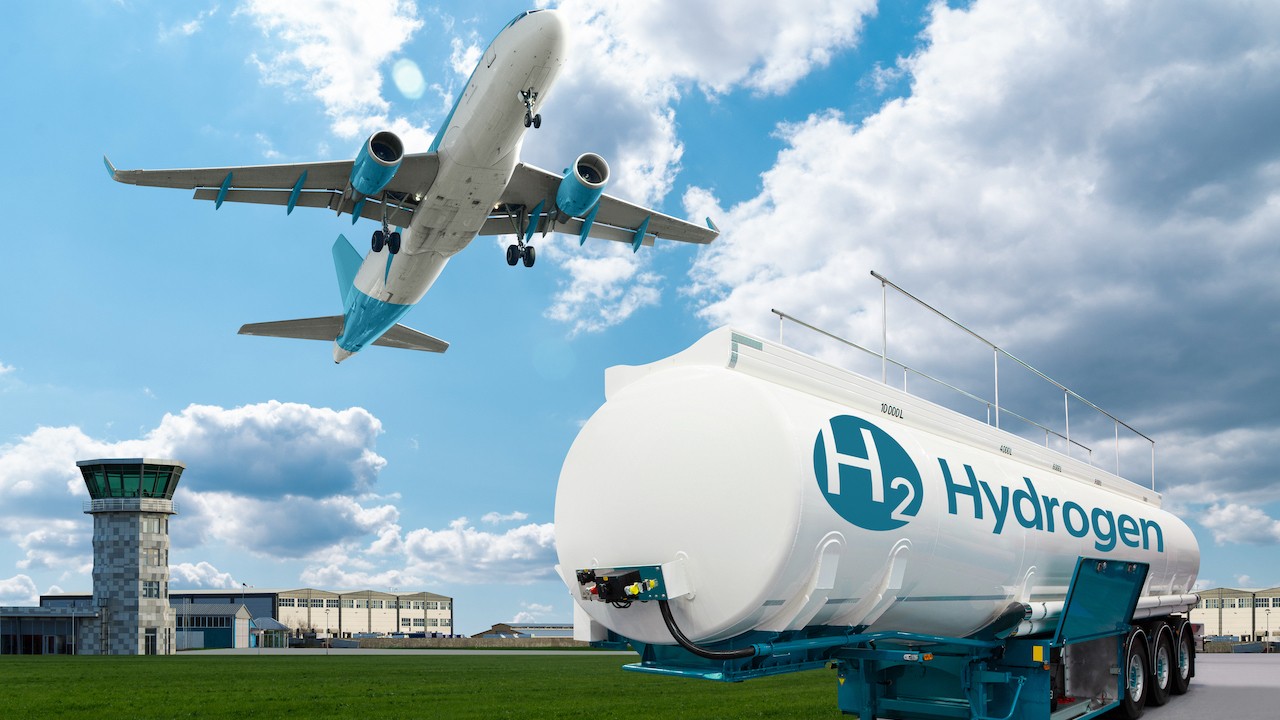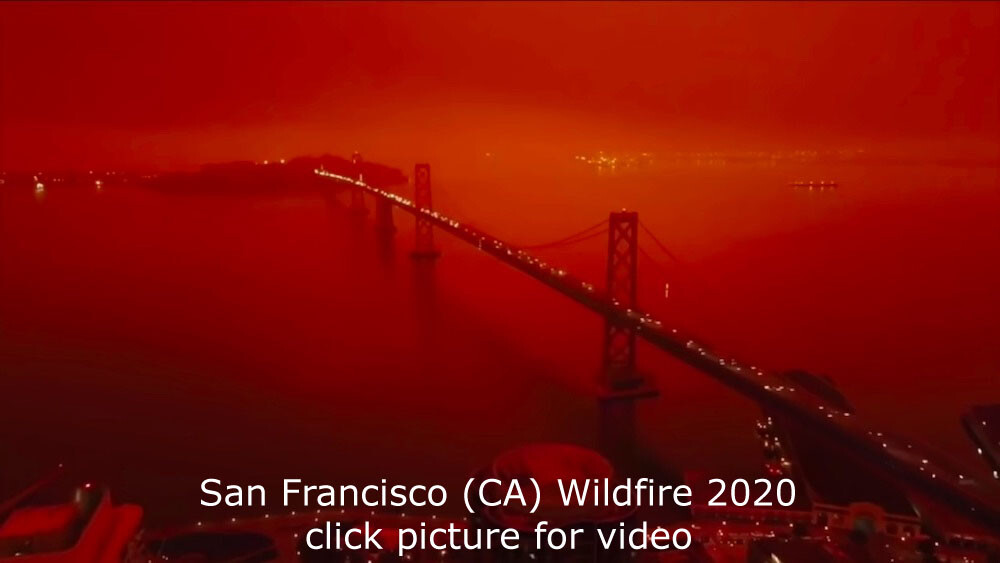UP TO 1.500 HUGE WINDMILLS NEEDED IN DENMARK TO COVER DANISH AVIATION's NEED ON PtX FUEL.
Foreword: This is a longer article, so if you just want the conclusion of this article, please see the chart below from Bloomberg NEF Michael Liebreich what Green Hydrogen is best at and what it probably or mostly likely can not compete with in terms of other and cost-wise more favorable Green energy sources.

By: John Martin Winther Andersen
In a recent article the Danish Aviation sector mentioned they would in contrast to its Scandinavian siblings in Sweden and Norway, focus on Power-to-X (PtX), or Electrofuel and later Hydrogen to replace the current usage of fossil fuel (Jet A1) in domestic and short-haul routes, in contrast to Norway and Sweden that believes more in electric powered aircrafts, despite they initially have shorter range but that opens up for other routes.
At eVTOL.dk we have no biased relation to either Hydrogen, its derived child PtX/electrofuel or to SAF (Biomass) or battery-powered aircrafts or any other green energy source for that matter. All we want as an environmentally responsible company, is that we choose what ever energy source is the best for a given task, need, problem etc., meaning it has to be the cheapest solution to be able to outcompete fossil-fuel energy (Jet A1 in Aviation) on free open market terms, but a solution that at the same time favor the environment by being really CO2 neutral and not just offsetting its emissions, because as we have documented when the consumer purchase a flight ticket, price is the dominant factor no matter if the energy used to propel the aircraft is green, grey, blue or black, where the last three (grey, blue and black) are all based on fossil fuels, and that offsetting emissions does not in general work in real life.
Today we all know that we have to decarbonize our way of living. As mentioned previously, according to United Nations; ".. We should reduce greenhouse gas emissions because if we don't, it's going to get really bad .." and ".. There is a brief and rapidly closing window to secure a liveable future on the planet ..".
The large fossil-fuel companies that produces the products that emit a majority of the total CO2, have known about their products environmental impact since 1977 and since tried to control the narrative for decades in for example putting the "choice" and later blame on the consumer of using their products.
Get sued if we don't uphold our promises
This decade old blame tactics used by fossil-fuel companies have lately caught up with todays reality with the landmark case in Holland, where fossil-fuel company Shell lost in court for not having done enough to adhere to policies of cutting down emissions and ordered by court to do so. A court ruling we believe our own industry, Aviation, need to take notice of since IATA has claimed Aviation will be Net-zero in 2050, because if a fossil-fuel company can be ruled for not doing enough for the environment in accordance to set targets despite it is the customers who actively emit the majority of the CO2, we as an industry should expect to be held up to the same level of standards we put out to do what we claim we will do for the environment, or we believe we could risk future court rulings will rule against us.
So when the Danish Aviation sector goes another way than our two sibling-countries, it made us wonder if Denmark despite being a minority out of three countries, found a better way or reason than the other two and digged into the pros and cons of choosing Hydrogen or Hydrogen-derived fuels such as PtX/Electrofuel instead of SAF (Biomass) and battery powered energy.
Is Hydrogen at large the savior for Aviation ?
Hydrogen is at normal temperatures a gas and the most abundant element in the universe, but on earth it's usually not found naturally alone but attached to other elements like water, methane etc.. It is also the smallest element hence it's more difficult than other elements to keep from leaking out through its containment materials (tanks, pipes, joints, couplings, sealings etc.).
We look at two ways to storage Hydrogen.
- As a gas under pressure at ambient temperatures in a pressurized tank.
- Liquified kept below -253 degrees celsius temperature in cryogenic tanks.
Liquified Hydrogen is what Aviation most likely plan to use, as liquid Hydrogen has a higher amount of energy per unit volume than as a gas, and space also matters in an airplane. Hydrogen as a liquid has a boiling temperature at -252,9 degrees celsius, meaning it has to be cooled down to at least -253 degrees celsius in special cryogenic tanks or it will boil into a gas.
Compared to Jet A1, Hydrogen as a fuel no matter if its a gas or a liquid has a very little energy per volume (liter), 0,5-1,4 kWh/liter depending on the pressure it's under in the tank or 2,3 kWh/liter as liquified Hydrogen. In contrast Jet A1 has 9,6 kWh/liter, so a factor of 4-19x, meaning the same energy needed for a specific flight of Hydrogen used in the same type of engine, occupies 4-19x more space in the airplane, meaning a need of much larger fuel tanks than current Jet A1 require.
Note: If the airplane used propellers instead of a turbofan and use fuel-cell technology instead of a turboprop engine to power the propeller, up to an approx. 20% efficiency comes into the hydrogen powered aircraft favor. But subtracting 20% from a 4-19x factor still leaves a huge factor difference in favor of Jet A1. This is to say we recognize there is a smaller efficiency factor for Hydrogen + fuel-cell technology, but in this article we exclude it to keep it as simple as we can.
On top of the very little energy per volume in contrast to Jet A1, current aircrafts has all or the wast majority of their Jet A1 fuel in its wings. By design that is a great idea, because the wing then lifts the weight of the fuel where the fuel is. This demands less needed structure in the aircraft at the joints of its wings and the fuselage. As Lecturer in Airplane Performance, Bernard Dijk van from the independent organization, Hydrogen Science Coalition, explain in this video and follows up with why promises from a Hydrogen cryogenics tank developer are not valid in real life:

Unless we start flying in aircraft designs something like the Airbus Beluga cargo airplane converted to passengers with space for pressurized or liquified Hydrogen in its hump, or radical new airplane designs comes to market like for example flying wings concepts that might be able to storage some Hydrogen tanks in the wings structure, then flying on Hydrogen in current airplane designs already face serious challenges and limitations, that likely can not cost-wise compete with using fossil-fuel or maybe not even the more-expensive-than-Jet-A1, SAF (Biomass), which both fuel types can go into the wings (or battery on light/regional- and short-haul flight), as shown on Michael Liebreich chart above.
Additional challenges using Hydrogen
The following issues and concerns in the daily operation of a Hydrogen powered aircraft need considerations for an overall assessment of pros & cons:
- New Infrastructure: To deliver Hydrogen from windmill/solar cell -> electrolysis plant -> truck or long distance Hydrogen (new) pipeline -> airport cryogenic tank facility -> airport Hydrogen fueling system -> airplane, a new infrastructure is needed.
- Low Energy/Volume: Due to Liquid Hydrogen's much lower energy per volume (4-19x less than Jet A1), a larger nozzle should be expected to refuel airplanes, if turn-around times are to be kept at current level, meaning probably a heavier fueling system that no single man/woman can handle alone and therefore likely has to be fully or partially automated.
- Regularly Spillage: To fuel an airplane with Liquid Hydrogen, if using the proven Thompson coupling one have to purge the pipes first with Helium due to its even lower boiling point than Hydrogen, because practically no Oxygen like from the air are allowed into the cryogenics tanks or pipes. But Helium is not recycled in this matter and is a scarce nearly finite resource on earth and also used for other and important purposes like cooling magnets in MRI scanners, computer business etc.. If the clean-break coupling though not expected used before year 2050 is used instead of the Thompson coupling, usage of Helium is avoided but there will be a small spillage per refueling process of an airplane of up to 0,5 dl of Hydrogen that vent into the atmosphere. Hydrogen itself is a bad Greenhouse Gas, in short term it is up to 100x more potent than equal amount of CO2.
- Daily Loss: Even the largest Cryogenics tank depletes from 0,2% per day or more of its liquid Hydrogen into a gas and from there into the atmosphere, since it's hard to expect that every tank facility at every large and small airport has an expensive Claude cycle plant to recapture and liquify it back, meaning it went out daily a gas 100x more potent than equal amount of CO2. The smaller the cryogenics tank, the higher percentage we can expect it to deplete of up to a couple of percentage of its volume per day.
- Explosive and Safety: In contrast to Jet A1 or its equivalent SAF that "just" burns if heated enough or under enough pressure, Hydrogen if out of control is rather explosive and can ignite with even just small amount of heat or energy. We have to consider that accidents and incidents sometimes happens where there are humans involved, so to mitigate that and to keep the Swiss Cheese model in use in regards of avoiding accidents and incidents, several measures must be implemented to make sure no single or a few human and/or technical faults can turn Hydrogen into an inferno in an aircraft.
- Planning: If other countries does not implement the same availability of Hydrogen as Denmark claim it will, what effect and limitations does it put on the operator in regards of refueling, planning for alternative airports etc. ?
The challenges of Hydrogen's very low energy per volume and the other challenges mentioned, can be avoided if we instead of fueling Pressurized or Liquid Hydrogen on an aircraft designed to fly on Hydrogen, convert Hydrogen into Power to Liquid (PtL) with CO2 capture. Then it will be more/less as easy to handle as current Jet A1 and SAF (Biomass).
But there is a catch converting Hydrogen into Power to Liquid, more about that later.
Producing the renewable energy to make Hydrogen
If we are to produce and use Liquid Hydrogen instead of fossil fuel in our aircrafts, we have to produce the energy needed from renewable sources, like wind-turbines and solar cells, and not as it is done in 99% of the cases today, where it's made of fossil fuels. But how much energy do we need from wind-turbines alone to do this ? - let us crunch some numbers.
In 2019, that is pre-COVID19 when the world was still normal travel-wise, Denmark used/sold 1.3 billion liters of Jet A1 fossil-fuel. An amount we shall expect increase by an average of approx. 3% per year as need for air travel historically increases year on year (except in unusual times like pandemics, major wars and conflicts etc.). Meaning if we continue to fly on liquid fuels as today, we shall expect a need of Jet A1 or an equal substitute of it in year 2030 of 1,7 billion liters, year 2040 of 2,2 billion liters and year 2050 of 3 billion liters.
Note: This subject can for many be a bit complex, so to simplify the understanding we have excluded the possible small single-digit percentage efficiency that Hydrogen can have over Jet A1 in form of its lighter weight as mentioned in Mr. Bernards video, because several factors alter that small efficiency from a single-digit percentage at best to near nil at worst, factors like size of aircraft, needed range / loaded fuel quantity etc.. We recognize there can be one, but in the grand picture in this article, it doesn't make much of a difference.
So how much electricity does the used/sold Jet A1 equates to ?
- 1,3 billion liters Jet A1 = 12,5 billion kWh using 9,6 kWh/liter
- 12,5 billion kWh = 12,5 tWh
But we need more than the 12,5 tWh of energy from the windmills to produce enough Liquid Hydrogen or alternatively (PtL) to swap out all Jet A1 usage in Denmark, because there is a major loss converting electricity into something like Hydrogen through an Electrolysis process, storage it as a gas or liquid or if we want to turn it into a PtL fuel.

Above chart from Transport & Environment shows a 32% loss turning electricity into gaseous Hydrogen under pressure (100% - 68% = 32%). According to the renowned expert, chemical engineer Paul Martin from the independent group Hydrogen Science Coalition, even with the best technology available only a 63% efficiency should be expected. So we will work with both numbers in this article to satisfy most readers, because as we stated in the beginning, we at eVTOL.dk have no favorite in what source of energy to use, as long as it is the cheapest AND really green alternative to fossil fuels.
This mean with approx. 3% increase of air travel per year post-C19, we will need the following amount of renewable electricity produced at the wind-turbines/solar cells to produce just the Hydrogen for Hydrogen powered aircrafts, if they come to market like Airbus has announced they are working on;
- 16,3 tWh liquid Hydrogen Year 2030 = 24,0 - 25,9 tWh wind-turbine energy produced
- 21,1 tWh liquid Hydrogen Year 2040 = 31,0 - 33,5 tWh wind-turbine energy produced
- 28,8 tWh liquid Hydrogen Year 2050 = 42,4 - 45,7 tWh wind-turbine energy produced
Note: To simplify it, we have not included the power needed to run these new electrolysis facilities, infrastructure, cooling of the cryogenic tanks etc. - and the likely min. 0,2% or more boil off loss of Liquid Hydrogen every day from its cryogenics tanks until the Liquid Hydrogen is used. So total power needed produced at the wind-turbines are even greater.
In comparison to make the number more tangible for people outside this business:
- Denmark as a whole country used approx. 35 tWh in 2019.
- All windmills in Denmark, land- and offshore, produced 16,14 tWh in 2019.
- Horns Rev 3 windmill park 49 new 8,3 MW mills produce from 2019 approx. 1,7 tWh.
Producing PtX fuel
To avoid all the issues handling liquid Hydrogen and the risk associated with it as mentioned above and because there is no Hydrogen powered aircrafts (yet), what will the energy need look like if we instead produced PtL fuels that can more/less work as it in the current aircrafts ?
The answer is quite simple. The chart above shows a 45% loss of energy producing Power-to-Liquid (PtL). According to chemical engineer Paul Martin we are more likely in a real world looking at a loss of 70%, in other words if we are to swap out all Jet A1 with PtL fuel, we need from the wind-turbines / solar cells the following;
- 16,3 tWh liquid PtL in Year 2030 = 29,6 - 54,3 tWh renewable energy produced
- 21,1 tWh liquid PtL in Year 2040 = 38,4 - 70,3 tWh renewable energy produced
- 28,8 tWh liquid PtL in Year 2050 = 52,4 - 96,0 tWh renewable energy produced
Note: To simplify it, we have not included the power needed to run these new electrolysis facilities, CO2 capture facilities which is said to be significant, infrastructure, etc.. So total power needed produced at the wind-turbines are even greater.
A LOT of windmills
Bottom line, according to our survey and calculations, to swap all the Jet A1 used/sold in Denmark out with PtL in the years and decades to come, we need to just for this relatively small business that "Danish Aviation" relatively speaking is compared to all other business in Denmark added together, either:
- Produce today up to the same amount or more of electricity as the whole country consumes today.
- By year 2030 have raised and installed 17-32x the amount of wind-turbines parks the size of Horns Rev 3, equivalent to 833 - 1.568 MHI Vestas 8,0 MW wind-turbines.
- Use 60-110% of the total offshore wind-turbines capacity of the 49,5 tWh in 2030 the government has announced it will boost it up to.
- Denmark announced along with EU, Germany, Holland and Belgium that by the year 2050, 10.000 of the largest windmills will be raised in the North Sea delivering 150GW yearly, whereas nearly 2.500 is expected on Danish soil (approx. 37GW). Using a friendly 4,3 tWh / GW capacity factor that gives approx. 160 tWh. Meaning in year 2050 Danish Aviation will need approx. 33-60% of the energy produced out of the approx. 2.500 largest wind-turbines = 825 - 1.500 of the largest wind-turbines in 2050.
What we have illustrated here is, that according to our research, sources and calculations, even with the most Hydrogen-friendly data, Danish Aviation need over 800 wind-turbines just for Danish Aviation, and probably up to approx. 1.500 wind-turbines.
Bottom line: It's a massive waste of green energy producing Hydrogen let alone PtL.
In contrast for delivering the same amount of energy (or horsepower) at an aircrafts propeller or fan, battery powered aircrafts only need 13-30% of the produced wind-turbine electricity compared to PtL powered aircrafts, due to a lot less loss of energy in transmission, battery storage and that electric motors are A LOT more energy efficient than combustion powered engines. In other words, where ever a battery-electric aircraft can fly instead of combustion powered aircrafts, that route would only need 15-30% of the amount of wind-turbines. That is significant less amount of wind-turbines needed for battery-electric aircrafts, somewhere between 200-250 wind-turbines. Still a lot, so maybe we should also look into other green energy sources beside wind-turbines and solar cells ?..
"But batteries don't cut it and there isn't enough Biofuel, therefore we need PtL"
That is a statements that pops up regularly, especially about batteries. Sure batteries are not able to deliver enough energy per weight today to give any commercial plane a decent range, but the development is going fast.

We made this chart to roughly illustrate with past and current battery technology in cars, how fast it has gone since the first Tesla Roadster car in 2008 hit the market and kicked the automobile industry into electric gear, through the first Model S, then Model 3 and then the announced level of 400-500 Wh/kg in 2025 by other car manufactures and made a trend line where it looks like we are heading.
Note: there is a 400-450 Wh/kg battery on the market now for use in the space industry, so getting to 400-500 Wh/kg in cars by 2025 seems no longer just to be words.
Several other battery technologies with other material or chemical combinations than current types are under development, for example Lithium-air where a Japanese consortium has established a density of 500 Wh/kg. Lithium-air has a theoretical density of over 1.000 Wh/kg, so plausible good margin for further development just with this type. And other combinations of materials and chemicals are in the works for even higher energy density in the future to come.
Having consulted people who study and follow battery development for a living, they nodded that this scenario reaching approx. 800 Wh/kg by around year 2035 looked plausible. We can't tell the future, but so far batteries track record, projections and professionals in the industry seems to agree it is heading that direction.
What we also find interesting with an 800 Wh/kg energy density in batteries is as we have mentioned in this previous article, that approx. 50% of all flights, not measured by distance, but 50% of the number of all flights can then be flown on battery-powered aircrafts alone with no need of any fuel being burned, hence emitting no CO2 or any other gasses at the airport or to the airports local community (and likely less noisy as well). Being able to reduce emissions and noise locally like at an airport and to the airports local community, we find that important.
In addition to environment issues, battery-powered aircrafts does not create contrails, which is suspected to count for over half of aviations entire climate impacts.

According to this Forbes article, we just need to reach approx. 5-600 Wh/kg to be able to start flying regional with reference to this source / illustration, which follow very well the previous source of reaching approx. 800 Wh/kg, which then starts entering the narrow body airplanes domain (ex. Airbus A220/320, Boeing 737 etc.) up to 600 Nm short-haul routes.
Hybrid-electric solutions
Another interesting alternative we find not mentioned a lot in our traditional part of aviation, is hybrid-electric solutions as in having a combination of batteries and a gas-turbine engine using SAF (Biomass) that powers a generator, that parallel with the batteries can power the electric motor(s)/propeller(s) on the aircraft and/or charge the batteries en-route, so landing just like takeoff can be done on pure battery power with the gas-turbine turned off, i.e. no local emissions at the airport. Data on one of the eVTOL/eSTOL projects in the making shows us compared to a traditional turboprop airplane of similarly size, the hybrid aircraft while traveling at approx. same speed and at a same given altitude en-route, its fuel-flow is only approx. 40% of the traditional turboprop airplane.

Rolls-Royce seems to agree there is a market in hybrid-electric solutions, since they announced recently their program to support that need.
The hybrid-electric solutions is also useful to get some eVTOL/eSTOL quicker into a larger market than with pure battery powered solutions, until batteries in the near future will get a high enough energy-density per weight, so pure battery powered journeys can be done even further and not limited to approx. sub-150 miles ranges as the limitations are with current battery technology with eVTOL and a bit further for eSTOL aircrafts.
If we can conclude that producing Hydrogen or PtL for aviation is a waste of capital and green energy, due to SAF (Biomass) at some point will become a scarce resource, maybe we can lower the consumption of SAF (Biomass) by developing hybrid-electric aircrafts instead of trying to fly on Hydrogen and limit usage of SAF (Biomass) where batteries are not sufficient yet.
Ending words
Topics not covered in this article we looked into but kept out for simplicity reasons, but topics that should have considerations as well;
- Environmental impact: How recyclable are wind-turbines materials after their 20-30 years life ?
- Environmental impact: What influence does that many wind-turbines have to the atmosphere in term of for example change of windspeeds and precipitation on short and long distances from the wind-turbine farm ?
- Capital expenditure, private and public.
- Environmental impact: How recyclable are todays and futures batteries ?
We are aware of this article is in contrast of much of the current broad agenda in believing a lot in PtX and Hydrogen as a fuel. If you find faulty sources we refer to or miscalculated numbers, please let us know.
But if we have not quoted sources incorrect or done poor calculations, we believe it is obvious as it is for several other independent experts with many years of knowledge in their respective field, that Hydrogen is not the great savior for aviation. For that there are better alternatives that makes a lot more sense, i.e. battery and hybrid (battery + SAF) on short haul and SAF from bio-sources on long haul.

And if there is not enough bio-based SAF for all long haul flights, maybe some of the passengers for example those going on holidays where time is not as important, could book flights that are shorter or flights with technical stops underway to give time to for example recharge the aircrafts batteries and give the passengers time to stretch their legs and have a short break, just like you can when flying transatlantic with Icelandair via Iceland - or like in the old times when piston-prop planes didn't have to range to go non-stop over long distances they had stops underway.


